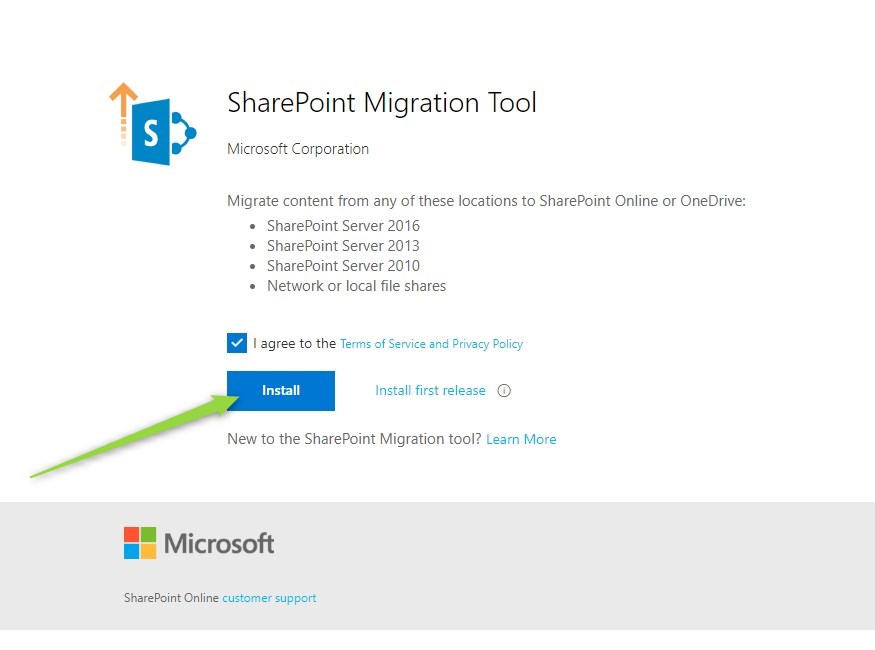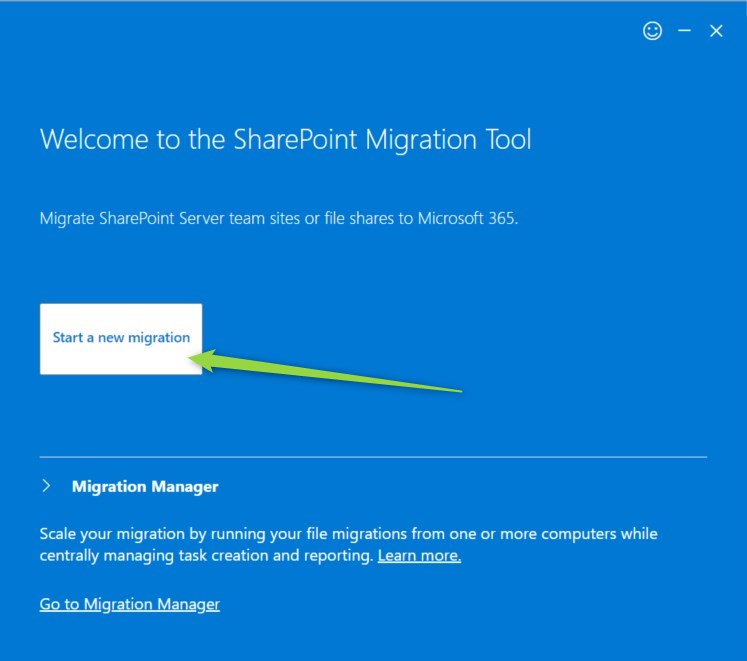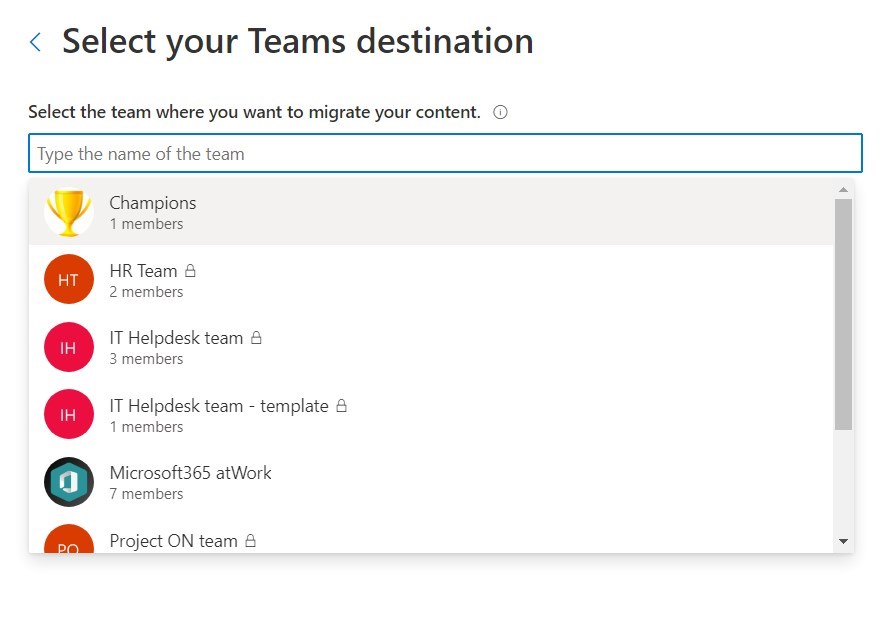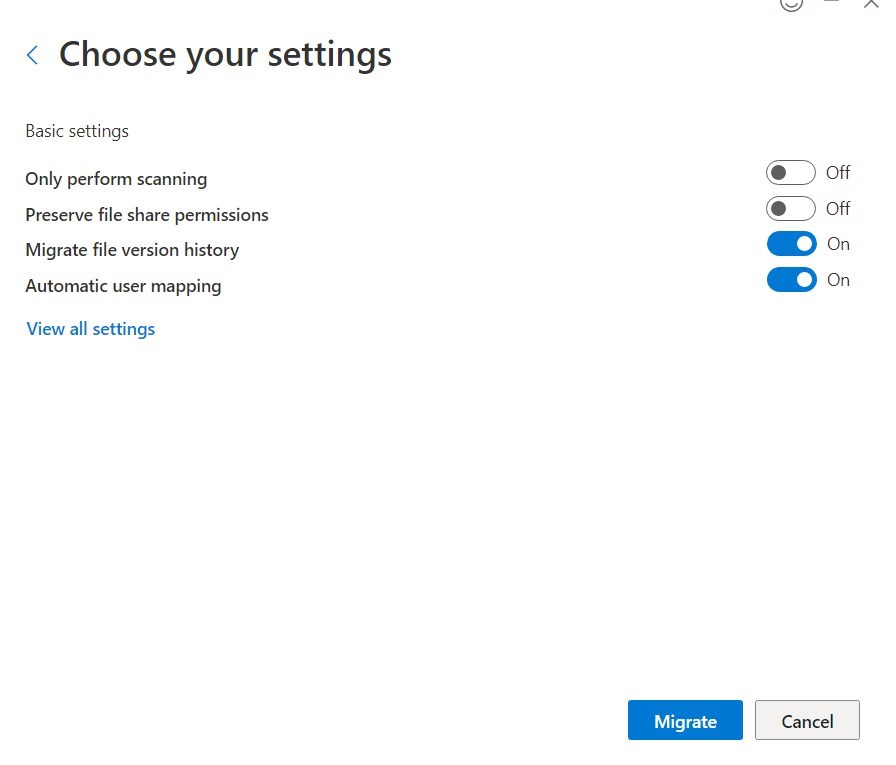SharePoint Migration Tool (SPMT) is a free migration tool provided by Microsoft.
You can use SharePoint Migration Tool to migrate the data to SharePoint Online, Microsoft Teams or OneDrive for business.
SharePoint Online and OneDrive are the fundamental Office 365 apps that store the data in the Microsoft Cloud. Sooner or later you will need to migrate some data to SharePoint Online and SharePoint Migration Tool is a free application that could help you manage the data migration process to Microsoft 365.
SharePoint Migration Tool is a great free tool that you can use to migrate the data to Office 365.
Learn how to use SharePoint Migration Tool in the data migration process.
What is SharePoint Migration Tool (SPMT)?
SharePoint Migration Tool is a free migration tool provided by Microsoft that allows you to migrate to SharePoint Online, OneDrive and Teams.
This is a great migration tool that could help you with simple migration scenarios without additional costs. You can also migrate large volumes of data to Microsoft 365 directly to SharePoint sites, OneDrive personal spaces or Microsoft Teams team Files.
When to use SharePoint Migration Tool?
You should select SPMT in your organization when you need to execute the migration of the data to Office 365. There’s no planning feature included in SharePoint Migration Tool so you should execute the migration now on the laptop or server which will be turned on during the migration.
In case you need to schedule or plan multiple migration workstreams you should consider other migration tools.
Supported migration scenarios in SPMT
You are able to migrate the data to Microsoft 365 from:
- local drives to Microsoft 365
- SharePoint Server to Microsoft 365
Data sources available in SharePoint Migration Tool
You are able to migrate the data to Microsoft 365 from:
- SharePoint Server 2010, 2013, and 2016
- SharePoint Foundation 2010 and 2013
- the local data file share
It means that you can migrate the data from all supported SharePoint Servers since 2010 and local drives and local shared drives.
Which SharePoint components can be migrated using SharePoint Migration Tools
In case of the SharePoint Server on-premise to SharePoint Online migration you will be able to migrate:
- Sites – Migrate a single site or include all your subsites. Optionally you can choose to modernize your site structure during migration
- Lists and document libraries – migration of the specific SharePoint List records or SharePoint Document Libary
- Workflows – migration of the SharePoint Designer workflows to Power Automate
These are the most crucial SharePoint components that you can migrate from SharePoint on-premise to SharePoint Online.
Key SharePoint features that can migrate using SharePoint Migration Tool
These are key SharePoint features you can migrate from SharePoint Server when you are migrating to Microsoft 365:
- File, folder, list items – Supports migration of files, folders, and lists.
- Permissions – Separate settings are available to set file share permissions and SharePoint on-premises permissions.
- Versions – You determine what file history is preserved.
- Managed metadata and taxonomy – SPMT supports the migration of content types and term stores. Global term store migration requires global tenant admin permissions.
- Navigation and icons – Site navigation for out-of-box sites is preserved and migrated.
- Site features – An extensive set of site features are supported.
- SharePoint web parts – SPMT supports migration of SharePoint web parts.
- Site migration – “Out-of-the-box” SharePoint sites that don’t use any coding or third-party tools can be migrated.
- Site description – Site descriptions can be migrated.
- Pages – Pages in the site asset library.
- Taxonomy migration – By default, managed metadata migration is turned off, and taxonomy is updated in incremental rounds.
Document shares elements that can migrate using SharePoint Migration Tool
These are key components of the Shared Drives when you are migrating to Microsoft 365:
- Documents
- File and folder structure
- User level file and folder permissions
- Files under 15 GB
SharePoint Migration Tool limitations
SPMT is a great migration tool dedicated to SharePoint but has some limitations that you should consider:
- There’s no support – If this tool will not work for your environment there’s not much you can do about it. I met the situations where SPMT did not work at all (could not connect on-premise SharePoint to Microsoft 365) and after tests, we had to move to a third-party solution. Always verify how it works for your environment and your business cases. If it will broke you will need to try to fix it, there’s no official support for the app.
- There’s no full modernization migration – Tool offers the possibility to modernize site structure from subsites to the modern hub with associated site collections. It is a very useful feature butt there’s no option to modernize any other components automatically.
- Does not support custom-developed sites, lists and libraries – if you have heavily customized SharePoint environment by developers you could be a blocker
- No scheduling feature in the tool – There’s no possibility to schedule the whole migration or the time when specific tasks should be done. You execute the migration at the time when you are using the tool.
- Limted logging – You can find some limited logs on the hard drive of your machine in the CSV format.
- There’s no support for SharePoint Server 2007 or Windows SharePoint Services 3.0 – You need to upgrade your environment at least to SharePoint 2010.
- There’s no support for SharePoint Server 2019 yet – At the moment SharePoint Server 2019 is not supported.
How to download SharePoint Migration Tool for free?
You can download SharePoint Migration Tool for free and install it on Windows PC.
? Download and install SharePoint Migration Tool for free
You can download this SPMT for free without additional costs. Here you will find a detailed license of the product.
How to install and setup SharePoint Migration Tool
On the SPMT landing page agree with the terms and select the Install button.
The installation package will be downloaded and you can execute the installation process of the SharePoint Migration Tool. In the first you will be asked to log in to your Office 365 tenant.
And that’s it, SharePoint Migration Tool is installed! Your migration can be executed by selecting the button Start a new migration.
You can do your first SharePoint Online migration.
Available features of SharePoint Migration Tool
SPMT offers multiple Office 365 migration scenarios.
Sources of the data migration to Office 365 in SharePoint Migration Tool
In the first step when you are set up the migration you can choose from
- SharePoint Server – You can connect to SharePoint Server 2010, 2013 and 2016 and try to migrate the data from these platforms to SharePoint Online.
- FileShare – Shared Drives when you are migrating the files and folders to the Office 365
- JSON or CS file for bulk migration – semi-scripted model when you are preparing migration setup and mapping based on CSV or JSON files.
In this step select your data source and start the Office 365 migration configuration.
Migration of the SharePoint Server to Office 365 using SharePoint Migration Tool
SPMT allows you to the migration from SharePoint Server and also do some modernization of the components available on your on-premise environment.
You will have the possibility to migrate a few elements available in the SharePoint Server. Remember the most important part is to connect to on-premise SharePoint server using an account that will have access to the SharePoint data
Migration of the SharePoint site
In this case, if you would like to migrate the SharePoint site with the whole structure behind it SharePoint Migration Tool will allow you to automate that migration and moreover it will offer the possibility to modernize the structure f the subsites and convert it to the hub.
This operation could be very helpful but remember it could require additional work from your side and work with business owners. Modernization of the SharePoint site could be quite complex process.
Migration of the SharePoint list or document library
You will also have the possibility to migrate specific parts of the SharePoint date structure like the document library or SharePoint list.
Migration of the SharePoint workflows
SPMT offer the possibility to modernize some SharePoint out-of-the-box Designer workflows and convert them to Power Automate. Remember this is quite a limited feature.
Migration of the data from Shared Drive to Office 365 using SharePoint Migration Tool
If you want to do the migration of the Shared Drives to SharePoint Online, Microsoft OneDrive or Microsoft Teams you can use the SharePoint Migration Tool to do that.
In the first step when you are set up the migration process you need to select drive and folder or folders you want to migrate (1) and select the migration model (2).
In the next step, you will be able to select the target location for your migration. You will be able select between Teams, SharePoint and OneDrive.
In case you will select the Teams as a target location for the data you will be able to select the team and channel.
For the migration to SharePoint Online you will need to put your SharePoint sites address and select library when the data will be migrated.
In the case of the migration to Microsoft OneDrive you will need to clarify the user email.
After this setup, you will be able to start the migration of the data to SharePoint, OneDrive or Teams. In the final step, just before you will execute the data migration you will be able to setup basic configuration of the migration process. To start the migration select Migrate button.
You learned how to setup the migration now learn what kind of migration options you have.
Migration options available in SharePoint Migration Tool
When you are starting the SharePoint migration you have multiple options available to use during the migration.
Available options in the SharePoint Migration Tool:
- Perform scanning before the migration – you will have the possibility to scan before the migration to verify possible issues. In case of a lack of problems you can automatically start the migration
- Preserving permissions – You will have the possibility to copy the permissions
- Automatic user mapping – you can automatically map users between on-premise and cloud environments. In the case where a lack of some users in the cloud will generate migrations issues, you could need to prepare to mapping.
- Migrate version history – you can keep version history of the files
- Include hidden files
- Files excluding filters – that will allow you to exclude some files based on creation date, modification date or extensions
- Fixing the files special signs
- Working folder – You can change the localization of the temp folder for the migration.
Errors in using the SharePoint Migration Tool app
Of course, when you are using SPMT you can meet possible errors and problems. One of the most important elements that need to be guaranteed are proper connections to local storage or SharePoint Server and to SharePoint Online.
Below I’m presenting some of the most popular problems you can experience and the table of the error codes.
SharePoint Migration Tool logs
You can find the log from SPMT working on the local computer in the localization: C:\Users\USERNAME\AppData\Roaming\Microsoft\MigrationTool\
Sharepoint Migration Tool stuck at 99 / 98
There could be multiple reasons behind this error but at the same time in many case SMPT is doing something but these actions are not visible. Wait for additional 30-45 minutes and then check if:
- throttling was executed on Office 365
- storage on local computer or SharePoint site get to some limit
- app stuck
If none of these elements happened check the logs of the app.
Sharepoint Migration Tool throttling
Throttling is a native security feature on Office 365 and it is not much you do about it. Prepare at least a few user’s accounts for the migration. One of the workarounds is to switch the account used to execute the migration.
Sharepoint Migration Tool local temp
Native localization for the SPMT temp is the C drive. Take in consideration that in case of migration temp could multiply the size of the migrated data. The migration option allows you to move it to another drive.
Sharepoint Migration Tool error codes
| Error Code | Action |
|---|---|
| 0x0201000D | Check if the list exists or if you can access it in the source site and target site. |
| 0x02050008 | Unable to access your local storage. Restart your migration. |
| 0x02010023 | Your source list template is not supported. Please try another. |
| 0x0201000C | Check your credentials and then reenter your username and password. |
| 0x02010017 | You must be a site collection admin. |
| 0x02060009 | 1 – The site collection cannot be created because the URL is already in use or an invalid URL. |
| 2 – The site collection cannot be created because the URL contains invalid character. | |
| 3 – The site collection cannot be created or updated. | |
| 0x02060007 | 1 – The site collection cannot be created because the URL is already in use or an invalid URL. |
| 2 – The site collection cannot be created because the URL contains invalid character. | |
| 0x02010018 | 1 – Check your credentials and then try again. |
| 2 – A problem occurred accessing SharePoint. Check your credentials and try again. | |
| 3 – A problem occurred accessing SharePoint. Check your credentials and your network connection and try again. | |
| 4 – A problem occurred accessing SharePoint. Check your credentials and your site URL for accuracy and try again. | |
| 5 – A problem occurred accessing SharePoint. Check your credentials and the format of your URL. Retry. | |
| 6 – A problem occurred accessing SharePoint. Check your credentials and try again. If the problem continues, please create a support case. | |
| 7 – A problem occurred accessing SharePoint. Check your credentials and try opening your site in a browser. | |
| 0x0204000A | Cannot create package file. All files and folders in the SPMT working folder, %appdata%\Microsoft\MigrationToolStorage, must be closed. Restart your migration. |
| 0x02030001 | 1 – Check your credentials. Restart your migration. |
| 2 – Check your credentials. Restart your migration. | |
| 3 – Check your credentials and your network connection. Restart your migration. | |
| 4 – Check your credentials and your site URL. Restart your migration. | |
| 5 – Check your credentials and the format of your URL. Restart your migration. | |
| 6 – Check your credentials and restart your migration. If this continues, please a support case. | |
| 7 – Check your credentials and try opening your site in a browser. Restart your migration. | |
| 0x02010008 | Confirm the path and format of the user mapping file and that you have permission to access it. |
| 0x02050001 | All files and folders in the SPMT working folder, %appdata%\Microsoft\MigrationToolStorage, must be closed. Restart your migration. |
| 0x02010002 | Check your network status. If you can access the source sites from a browser, then create a support case. |
| 0x02010010 | Make sure the source list and target list have the same template. |
| 0x0204000D | All files and folders in the SPMT working folder, %appdata%\Microsoft\MigrationToolStorage, must be closed during migration. Restart your migration. |
| 0x02040012 | The temporary storage on your local computer is too low. SPMT caches the package on the working folder. Expand your temporary storage and retry. |
| 0x02030003 | There are too many items with unique permissions. Simplify your permissions list by reducing the number of unique permissions. Retry your migration. |
| 0x02050001 | Local storage file is corrupted. The working folder was touched or modified during the migration. Retry your migration. |
| 0x02080001 | The file in the package has been changed or deleted while uploading. All files and folders in the SPMT working folder, %appdata%\Microsoft\MigrationToolStorage, must be closed. Restart your migration. |
| 0x02010006 | The source SharePoint site does not have any defined role definitions. Check to see if your role exists when accessing source site. |
| 0x02040009 | The package can’t be created because the directory cannot be found. All files and folders in the SPMT working folder, %appdata%\Microsoft\MigrationToolStorage, must be closed. Restart your migration. |
| 0x02010020 | Disable migrating version history in SPMT settings or enable versioning in SPO. |
| 0x0201000E | Check if the global setting has filtered out special characters in the target path or if the path has unsupported characters. |
| 0x02010016 | We are unable to find your SharePoint Server user. Make sure you are a site collection admin. |
| 0X0201000F | Invalid site URL. Check if the site URL is valid. Try to access the URL via a browser. |
| 0x0207001 | You do not have access to the task folder. Check if you can access %appdata%\Microsoft\MigrationToolStorage. |
| 0x01410010 | A failure occurred because of missing dependencies on list items. Check the FailureSummaryReport.csv for details. Check if the dependencies have been included in your migration scope. |
| 0x01510001 | Packages failed to upload. If you have customized Azure Storage, check if you can access the Azure Storage and check if you can access the target site. Try migrating again. |
| 0x01510001 | Failed to Upload the Job to Server: Upload file failed during migration. |
| 0x02070009 | Several packages failed to upload. Pause the task and check your network connection. |
| 0x01710009 | A failure occurred due to job end failures; some items failed in the package. Restart migration. |
| 0x01710009 | Errors or timeout for Server Processing the file: Not all the items in the package have been migrated. |
| 0x01610001 | The Azure container is expired. Retry migration task. |
| 0x01710006 | Errors or timeout for Server Processing the file: Job Fatal Error. |
| 0x01710004 | Errors or timeout for Server Processing the file. Fail to look up folder name. The item may exist in other list or site in the same site collection. Or the item is in the recycle bin. |
| 0x0131000F | Failed to Read the file. File is checked out. |
| 0x0111000A | Scan File Failure: File size exceeds limit. |
What’s next?
Great! Now you know how to start using SPMT for data migration. Now is the time to learn more about Office 365. Learn about SharePoint Designer workflows in SharePoint Online, how to fix the performance of SharePoint or deploy SharePoint Lookbook templates.
Do you want more?
I prepared more articles around main Office 365 apps, like Exchange Online, Microsoft Outlook, Microsoft Teams and SharePoint Online.
Conclusion
Learn how to use the free SharePoint Migration Tool and migrate your data to Office 365: SharePoint, OneDrive or Teams from on-premise.




















Thanks. Would also like to have an article on Google Workspace migration to SharePoint.
This a plan 😉
I am not getting the option to migrate workflows. Any ideas?
Which SharePoint version you are migrating?
Plus Workflow migration is in Public Preview and Workflows created with SharePoint Server Designer 2013 or SharePoint Server 2013 are currently not supported.
This feature is during the development.
Great work , I would to ask , Why tools like ShareGate , Gs Richcopy 360 and Goodsync better than SPMT ? What is in these tools and not found in SPMT ?
hi, I have a question. How can I re-migrate the document library from on-premises to another sharepoint site? I migrated to the wrong site’s library and want to re-migrate them to the correct one. How and what are the steps? can share it with me. I appreciate any help you can provide.
You can use “Copy To” feature in SharePoint or do the migration again with new target library using Migartion Tool.